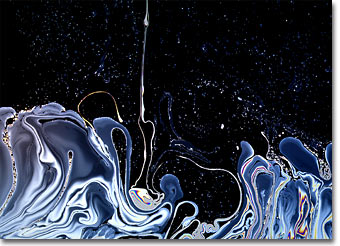Karl E. Deckart
Soap Bubble Gallery: Image Nine
German photographer and artist Karl E. Deckart is known for his thorough, precise, and beautiful work both in photography through the microscope and with macro camera systems. This gallery of interference photographs made with soap films is a testament to both Deckart's skill as a photographer and his understanding of the physical phenomena that surround our everyday lives. Presented below is soap bubble image number nine in small format. Click on the image to download a larger version.

|
Macrophotography of thin soap films freely suspended on a 4 x 4-inch wire frame was conducted with a Linhof large-format bellows camera system utilizing 4 x 5-inch sheet film and imaged using an apo-macro Nikon large format Nikkor-AM ED 210 mm f-5.6 lens. To prepare the soap film, equal parts of water, glycerin, and dishwasher detergent are thoroughly mixed in a container until a solution containing evenly sized micelles is achieved. A freestanding film is formed by dipping the wire frame into the solution and withdrawing carefully to maintain an even film thickness and avoid disruption of material flow across the frame rails. After suspension, the film was illuminated by a reflected light source positioned a few degrees from the camera system. The light was passed through a diffusion screen to avoid bright spots and provide an even illumination across the field. No polarizers were employed in photomacrography of soap thin films. Image ©1999 by Karl E. Deckart. All rights reserved. |
Detergents contain complex chemical structures that are called optical brighteners, and many are jealously guarded trade secrets. These specialized dyes cling to textile fibers during the washing process and remain after rinsing. The embedded dyestuffs make colors appear brighter because they convert invisible ultraviolet light into reflected visible light. The added reflected light derives from the visible blue-violet portion of the color spectrum, which makes blue colors appear brighter. Yellow hues, being the complementary color of blue, appear brighter as well. Before brighteners, a technique known as bluing was employed to make fabrics look whiter. However, this method of applying blue dyes to fiber actually increased the absorption of yellow light. Therefore, although enhancing blue tones, this early technique had the drawback of causing yellow colors to appear faded.
BACK TO THE SOAP BUBBLE GALLERY
